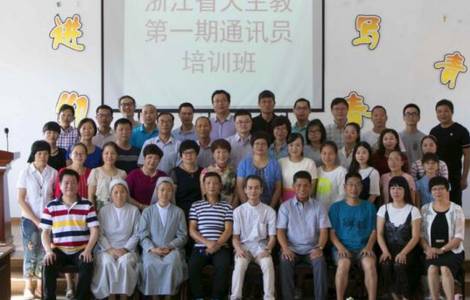
Tangshan (Agenzia Fides) - Encourage the growth of a widespread network of local operators and "reporters" willing to tell and share with others stories of Christian witness, information on the life of local Catholic communities, reflections on the Gospel and the truths of Christian doctrine. It was this challenge which, in the last week of June, prompted the Culture and Communication Center of the Catholic community of Tangshan (Hebei province) to organize a training course for 19 aspiring "grassroot correspondents" willing to write and share information and stories collected in every corner of the province. The people who participated in the course came mostly from rural villages in the most remote counties or industrialized districts, all motivated by the desire to also experience their training in the field of communication tools within the framework of their vocation as baptized and their participation in the life of their parish community. At the end of the course, awards were given to the authors of the best articles written on the Year of Charity, celebrated by the Catholic community of Tangshan in 2021 (see Fides, 15/1/2023).
The formation course organized in Tangshan and led by Father Li Haiyang, director of the Culture and Formation Center, is the expression of a singular and relevant phenomenon that occurs among the basic Catholic communities in China: the rapid and spontaneous development of "popular journalism" or "proximity journalism", which also uses the new digital communication tools to disseminate testimonies, news and reflections generated by the Christian experience. These networks are developed on a local basis, even in inland areas and far from major urban centres.
As early as 1991, on the initiative of priest John Baptist Zhang, Xinde ("Faith"), the first Chinese Catholic newsletter reborn after the years of the Cultural Revolution, was launched. The network of media and digital communication tools linked to the various Chinese Catholic dioceses and communities has grown exponentially, especially since the first years after the year 2000. The various printed bulletins have also been republished in digital version, websites and social media accounts such as WeChat belonging to Catholic communities scattered across the country have multiplied. Over time, after the initial start of the "artisanal" methods, the level of competence in the professional management of the new communication tools has also increased, as evidenced, for example, by the video clips edited by the team of young Catholics from Beitang, the Cathedral of Beijing, dedicated to the Immaculate Conception and founded by Venerable Matteo Ricci. These are mostly girls and boys accustomed to the use of new digital technologies and who have also infected older people with their passion for communication.
Offices and communication courses linked to dioceses and parishes have been inaugurated everywhere, in Shanghai as in Sanyuan, in Xianxian as in various dioceses in the provinces of Zhejiang, Shandong, Fujian. related to dioceses and parishes have been opened everywhere, in Shanghai as in Sanyuan, in Xianxian as in various dioceses of the provinces of Zhejiang, Shandong, Fujian. The heads of the various communication centers linked to the dioceses also invite lecturers and specialists from the communication faculties of Chinese and foreign universities to intervene in their refresher courses. They are particularly attentive to supporting the improvement of skills in the professional management of communication tools and techniques, without ever separating this commitment from the vocation of faith which alone can animate and motivate the service rendered to the mission and to the proclamation of the Gospel also through the media. In this approach, intense and grateful participation in the life of the Church can also be expressed in the rigor with which the reliability of sources is verified and in the speed with which news is disseminated that can strengthen the faith of the people of God. (NZ) (Agenzia Fides, 8/7/2023)